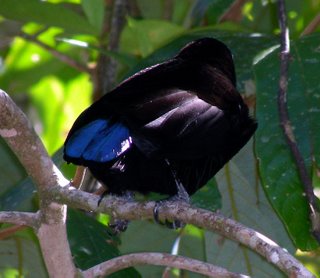 This male Victoria's riflebird (Ptilorus victoriae) is one of a group that visited the lodge at Lake Eacham every morning on the hunt for handouts. Although this individual and its pals were used to humans, they were all very active and difficult to photograph.
This male Victoria's riflebird (Ptilorus victoriae) is one of a group that visited the lodge at Lake Eacham every morning on the hunt for handouts. Although this individual and its pals were used to humans, they were all very active and difficult to photograph.Victoria's riflebird is one of three Ptilorus birds of paradise in Australia. The males of all three have velvety black plumage with an iridescent blue cap, gorget and tail. The feathers on the belly are tipped with dark olive green. The name 'riflebird' is apparently derived from the similarity of the male's plumage to 19th century British military uniform. (I've said it before and I'll say it again: common names are just plain silly.)
 A courting male attracts a female with a simple display in which he spreads his wings above his head in a dramatic pose. I saw them go through the same behaviour when two males disputed ownership of the diced apple on the bird table. The barneying birds also opened their bills wide to display bright yellow gapes. Very spectacular.
A courting male attracts a female with a simple display in which he spreads his wings above his head in a dramatic pose. I saw them go through the same behaviour when two males disputed ownership of the diced apple on the bird table. The barneying birds also opened their bills wide to display bright yellow gapes. Very spectacular.They dominated the bird table, seeing off Lewin's honeyeaters and any other small intruders. But a male met his match in a Macleay's honeyeater. Although these are more reserved that the cheeky Lewin's honeyeaters, one flew down to the table and stole a piece of fruit out of the riflebird's beak. There was plenty to go around. I think it was just making a point.
 They are vocal birds, announcing their presence with unmusical rasping calls. Maybe they don't have to be melodious when they are so gorgeously clad? When they fly, the males make a sound like rustling taffeta. Because of that they are easy to detect—just listen for the noise of a ballroom dancer swishing past ... in the trees.
They are vocal birds, announcing their presence with unmusical rasping calls. Maybe they don't have to be melodious when they are so gorgeously clad? When they fly, the males make a sound like rustling taffeta. Because of that they are easy to detect—just listen for the noise of a ballroom dancer swishing past ... in the trees.